1) Punjab Ratta:
3) Punjab Tropic:
6) Punjab Red cherry:
7) Punjab Varkha Bahar 2:
8)Punjab Varkha Bahar 1:
9)Punjab Swarna:
Other States Variety
1)HS 101:
2)HS 102:
3)Swarna Baibhav Hybrid:
4)Swarna Sampada Hybrid:
5) Keekruth:
6) Keekruth Ageti:
Soil –
Climate – Tomato is a day-neutral warm season crop
Seed Rate
Seed Treatment
To protect crop from soil borne disease and pest, before sowing do seed treatment with Thiram@3gm or Carbendazim @ 3gm of seeds. After chemical treatment, treat seed with Trichoderma@5gm/kg of seeds. keep it in shade. And use it for sowing.
| Fungicide/Insecticide name | Quantity (Dosage per kg seed) |
| Carbendazim | 3 gm |
| Thiram | 3 gm |
Time of sowing
Spacing
Depending upon variety use and its growth habit,
Sowing Depth
In nursery sow seeds at depth of 4cm and then covered with soil.
Method of sowing
Transplanting of seedling in main field.
Nutrient Requirement (kg/acre)
Recommendation for F1 hybrid is 250:250:250 kg NPK/ha.
Additional dose of 10 kg borax and 5 kg Zinc Sulphate, as basal dose also recommended for correcting fruit cracking and to increase yield and fruit quality.
Apply half dose of Nitrogen, full dose of Phosphorus and Potash applied as basal dose, apply it before transplanting. 20 to 30 days after transplantation apply remaining 1/4th dose of nitrogen.
When flowering starts in initial days, take spray of Boron@25gm/10litre of water. It will help to control flower and fruit dropping. Sometime black spots are observed on fruits, these are due to calcium deficiency.
Furrow irrigation is the most common method in tomato and the crop require adequate moisture throughout the growth period. Frequency of irrigation depends on the climatic and soil conditions. Water stress at flowering stage will adversely effect fruiting and productivity.
Plant growth regulators
Plant growth regulators are beneficial for early yield, increased fruit set at extreme temperatures and to impart resistance to viral diseases. However, their effect is not seen consistent and varied with genotype, climate, location etc. Some of the growth regulators found useful in tomato production are :
Purpose | Growth regulator | Mode and time of application |
High yield | GA1 (5-25 ppm) | Seed treatment |
PCPA (10-20ppm) | – | |
DNOA (25-50ppm) | – | |
GA (10 ppm) | Foliar spray | |
NAA (1000 ppm) | – | |
PCPA (50 ppm) | – |
| ||
Increased fruit set | NAA (0.1 ppm) | Seedling soaking for 24 hours |
Increased fruit set | IAA (50 ppm) | – |
In summer | Borax (1.0%) | – |
For increasing fruit set at low temperature | PCPA 50-100 ppm | Foliar spray at flower cluster |
Ripening of fruits | Ethrel 1000 ppm | Whole plant spray at the initiation of ripening. |
1.Training of Hybrids
2.Mulching-
Mulch with black LDPE sheets of 25 micron thickness and bury both the ends into the soil to a depth of 10 cm
3.Weed mat-
Production practices for cultivation of tomato under shade net.
During summer, the hybrid tomato can be grown in a shade level of 35 per cent
under paired row planting system (80 x 40 x 60 cm – between pairs, rows and plants) with a basal application of 50 kg each of N and K and 250 kg of P / ha and fertigation of 200 kg each of N and K through straight fertilizers.
1)Leaf Miner: Liriomyza trifolii
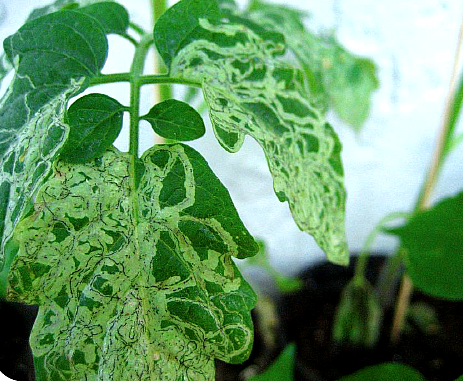
Symptoms-
Management:
2)White fly: Bemisia tabaci
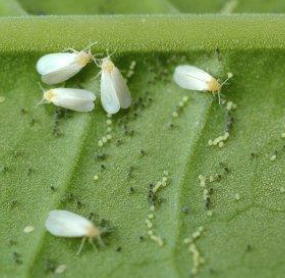
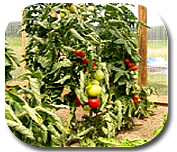
Symptoms of damage:
Management-
3)Thrips :

Symptoms of damage:
4) Fruit Borer: Helicoverpa armigera

Symptoms of damage:
Management:
5) Red spider mite: Tetranychus spp
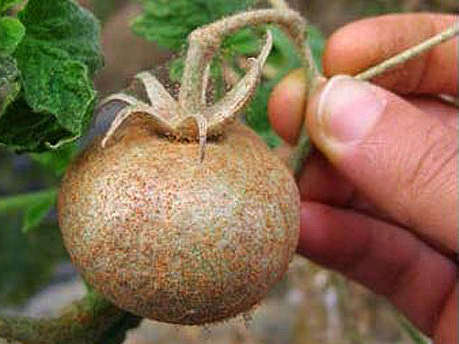
Symptoms of damage:
Management:
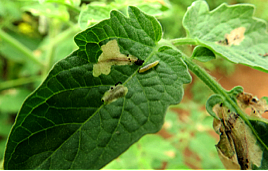
Symptoms
Management
Root knot nematode, Meloidogyne incognita is an obligate, sedentary endoparasite.
Symptoms
Above ground symptoms
Below ground symptoms
Management
Major diseases-
1.Damping off : Pythium aphanidermatum
Favourable Conditions
Management-
2.Early Blight:
Field Diagnostic Symptoms
Favourable Conditions–
Management
3. Fusarium Wilt :Fusarium oxysporum

Symptoms
Favourable conditions
Management-
4.Late blight: Phytophthora infestans
.jpg)
Symptoms
Favourable conditions :
Management:
5.Leaf curl : Tomato leaf curl virus
.jpg)
Symptoms
Management
6.Powdery mildew: Leveillula taurica / Oidiopsis neolycopersici
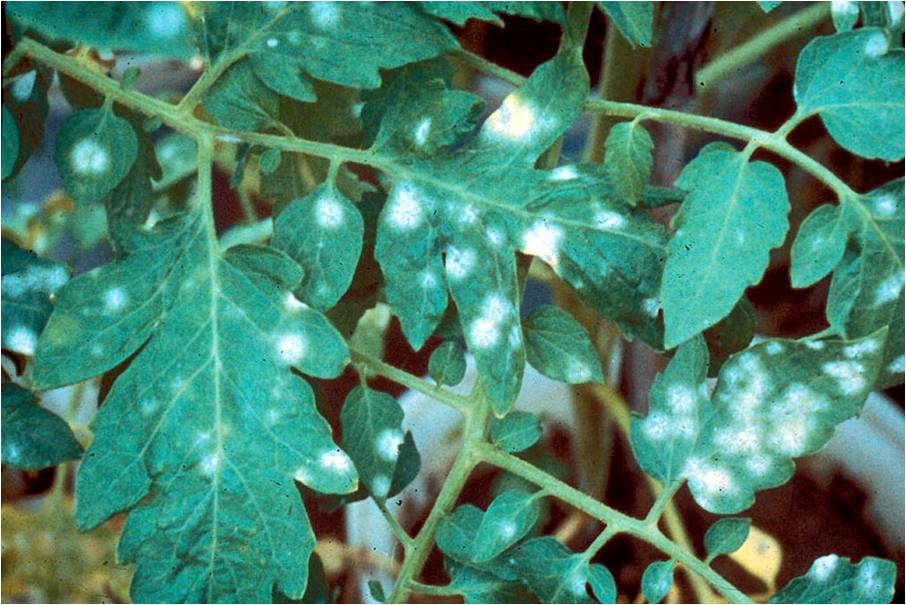
Symptoms
Favourable conditions
Management
.
1.Nitrogen-

Deficiency Symptoms :
Corrective Measure :
Foliar spray of urea 1% twice at weekly interval.
2.Phosphorus-

Deficiency Symptoms :
Corrective Measure :
3.Potassium

Deficiency Symptoms :
Corrective Measure :
Foliar spray of K2SO4 1% thrice at weekly interval.
4.Calcium

Deficiency Symptoms :
Corrective Measure :
Soil application of CaSO4 1 to 2 kg/acre or Foliar spray of CaCl2 0.5% thrice at fortnightly interval.
5. Magnesium

Deficiency Symptoms :
Corrective Measure :
6.Sulphur-

Deficiency Symptoms :
Corrective Measure :
Foliar spray of CaSO4 1% twice at fortnightly interval or gypsum @ 50 kg/ha.
7.Boron

Deficiency Symptoms:
Corrective Measure :
8.Copper

Deficiency Symptoms :
Corrective Measure :
Foliar spray of 0.5% CuSO4 twice at fortnightly interval.
9.Iron

Deficiency Symptoms :
Leaf veins remain green interveinal portion turns yellow young leaves small but not deformed.
Corrective Measure :
Foliar spray of 0.5% FeSO4.
10.Manganese

Deficiency Symptoms:
Corrective Measure :
Foliar spray of MnSO4 0.5% twice at fortnightly interval.
11.Molybelenom

Deficiency Symptoms :
Corrective Measure:
Foliar spray of NaMO4 0.05% twice at weekly interval.
12. Zinc
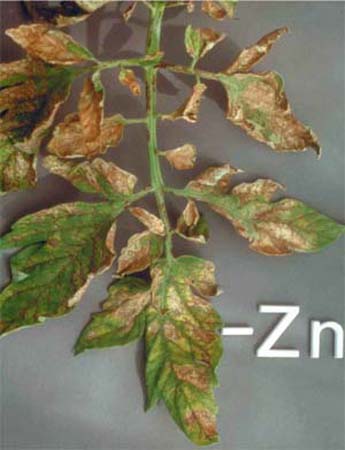
Deficiency Symptoms :
Corrective Measure :
Disorders
1.Fruit cracking
Fruit cracking is caused both by genetic and environmental factors. .
2.Blossom red rot
3.Sun scald
Due to extreme heat, tissues on exposed fruit develop a blistered appearance leading to sunken areas, which have a light or grey colour on green fruit and yellow colour on red fruit
Treat the seeds with metalaxyl-M 31.8% ES @ 2ml/ kg of seeds 24 hours before
sowing.
After harvesting, grading is done.
Varieties : 30-40 t / ha
Hybrids : 80-95 t / ha
Spray of bloom flower – N @ 2ml / litre at – 30, 55 and 75 days planting increase the yield.
Seed treatment with Pseudomonas fluorescens @ 10g/kg of seeds
Nursery application with Trichoderma viride and Pseudomonas fluorescens
Application of Neem cake @ 250kg/ha
Soil application of Pseudomonas fluorescens @ 2.5kg/ha
Selection of good and virus disease free seedlings for planting
Roguing out of virus infected plants upto 45 days of transplanting
Grow marigold as a border crop
Set up Helicoverpa / Spodoptera pheromone traps @ 12 numbers / ha
Release Trichogramma chilonis @ 50000/ha
Install yellow sticky traps
Spraying Neem formulations (1%) / Neem seed kernel extract (5%)
